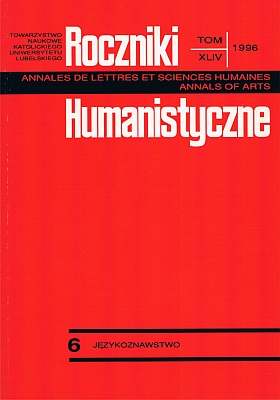Names in the Parish of Mikluszowice near Bochnia
Abstract
The subject matter of the present study are the baptismal names given to the children in the parish of Mikluszowice. The onomastic material was taken from register books covering three decades, from the end of the 18th, 19th and 20th centuries.
The ranking lists of the names in the periods in question (1784-1794, 1884-1894, 1984-1994) show a shift in tastes for different names. The names from the frequency lists worked out for the first two periods (Jan, Józef, Piotr, Franciszek, Marianna, Katarzyna, Barbara and Anna) correspond with the territorial groups of names showed by Bystroń for Little Poland (J.S. Bystroń, Księga imion w Polsce używanych). The frequency list of the last period, as compared with the ranking lists of the "urban" names (Białystok, Kraków, Opole), allow us to state that today one cannot distinguish an "urban" or "rural" name list. The vocabulary of rural names is close to that of all Poland. In the system of anthroponims of the territory under study, apart from traditional names, formerly defined as typically folk names like: Anna, Katarzyna, Karolina, Bartłomiej, Jakub, Maciej, and Mateusz, we find also some sophisticated, foreign names, without any tradition in the given territory, like for instance: Angelika, Lolita, Pamela, Patrycja, Adrian, Norbert, and Patryk. Drawing on the Angloamerican origin is a broader phenomenon, linked with the current name fashion.
There are many factors which presently motivate the choice of concrete names. What dominates today is the euphonic factor, the aesthetic value is essential (whether the name fits into the current fashion) and whether it harmonizes with the surname. Family tradition was an essential motivating factor for the previous generations, and it has preserved its importance in reference to second names. The religious factor (partly implying from the strong position of the Church or the priest himself, from authentic folk religiousness, and also from isolation and lack of other patterns than the liturgy calendar) which dominated in the previous centuries, has now become markedly limited and is a marginal factor.
Copyright (c) 1996 Roczniki Humanistyczne

This work is licensed under a Creative Commons Attribution-NonCommercial-NoDerivatives 4.0 International License.





